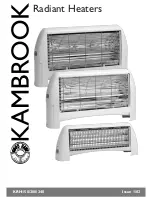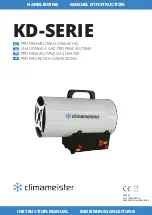
Form 433-CV/LN, Page 2
General (Cont'd)
Model FT heaters are design-certified by the Canadian Standards As-
sociation (CSA) to ANSI Z83.8a and CGA 2.6a for industrial/com-
mercial installations in the United States and Canada. Models FT 30,
45 and 60 are approved by the Canadian Standards Association to
IAS 10-96 for residential installations in both the United States and
Canada. All heaters are available for use with either natural or pro-
pane gas. The type of gas, the firing rate, and the electrical character-
istics are on the unit rating plate.
WARNING: Gas-fired appliances are not
designed for use in hazardous atmospheres
containing flammable vapors or combustible
dust, in atmospheres containing chlorinated or
halogenated hydrocarbons, or in applications
with airborne silicone substances. See Hazard
Levels, Page 1.
WARNING: Should overheating occur, or the
gas supply fail to shut off, shut off the manual
gas valve to the appliance before shutting off the
electrical supply.
WARNING: Do not use this appliance if any part
has been under water. Immediately call a
qualified service technician to inspect the
appliance and replace any gas control which has
been under water.
1. Installation Codes
These units must be installed in accordance with local building codes.
In the absence of local codes, in the United States, the unit must be
installed in accordance with the National Fuel Gas Code (latest edi-
tion). A Canadian installation must be in accordance with the CAN/
CGA B149.1 and B149.2 Installation Code for Gas Burning Appli-
ances and Equipment. These codes are available from CSA Informa-
tion Services, 1-800-463-6727. Local authorities having jurisdiction
should be consulted before installation is made to verify local codes
and installation procedure requirements.
Special Commercial Installations (Aircraft
Hangars/Repair Garages/Parking Garages)
Installations in aircraft hangars should be in accordance with ANSI/
NFPA No. 409 (latest edition), Standard for Aircraft Hangars; in public
garages in accordance with ANSI/NFPA No. 88A (latest edition), Stan-
dard for Parking Structures; and for repair garages in accordance with
ANSI/NFPA No. 88B (latest edition), Standard for Repair Garages.
ANSI/NFPA-88 (latest edition) specifies overhead heaters must be
installed at least eight feet (2.4M) above the floor. In Canada, instal-
lations in aircraft hangars should be in accordance with the require-
ments of the enforcing authorities, and in public garages in accor-
dance with CAN/CGA B149 codes.
ANSI/NFPA 409 (latest edition) specifies a clearance of ten feet (3.0M)
to the bottom of the heater from the highest surface of the top of the
wing or engine enclosure of whatever aircraft would be the highest to
be housed in the hangar, and a minimum clearance of eight feet (2.4M)
from the floor in other sections of aircraft hangars, such as the of-
fices, and shops which communicate with areas used for servicing or
storage. The heaters must be located so as to be protected from dam-
age by aircraft or other objects such as cranes and movable scaffold-
ing. In addition, the heaters must be located so as to be accessible for
servicing, adjustment, etc.
2. Warranty
Refer to the limited warranty information on the Warranty Card in the
"Owner's Envelope".
Warranty is void if ...
a. Wiring is not in accordance with the diagram furnished with the
heater.
b. The unit is installed without proper clearance to combustible ma-
terials.
c. The heater is connected to a duct system or if the air delivery
system is modified.
3. Uncrating and Preparation
This unit was test operated and inspected at the factory prior to crating
and was in operating condition. If the heater has incurred any damage in
shipment, file a claim with the transporting agency.
Check the rating plate for the gas specifications and electrical character-
istics of the heater to be sure that they are compatible with the gas and
electric supplies at the installation site.
Read this booklet and become familiar with the installation requirements
of your particular heater. If you do not have knowledge of local require-
ments, check with the local gas company or any other local agencies
who might have requirements concerning this installation.
Before beginning, make preparations for necessary supplies, tools, and
manpower. If the installation includes optional vertical louvers, install
them before the heater is suspended. Follow the instructions included in
the option package; option package is shipped separately.
4. High Altitude Operation
If the heater is being installed at an altitude between 2000 and 5000 ft
(610 to 1525M), check the rating plate to determine what must be done
to prepare the heater for high altitude operation.
Check the rating plate, determine which circumstance below applies,
and follow the instructions.
•
If the altitude range on the rating plate agrees with the altitude at
the site, no further action is required. Proceed with the installation.
•
If the altitude range on the rating plate reads "Sea Level" and the
altitude at the site is between 2000 ft and 5000 ft (610M to 1525M),
install the heater and follow the instructions in Paragraph 12 to der-
ate by manifold gas pressure adjustment.
NOTE: This heater is not designed for installation at an elevation above
5000 ft (1525M).
5. Unit Heater Location
Suspend the heater so that it is a minimum of five feet (1.5M) above the
floor. Other clearances are listed in Paragraph 7.
WARNING: If touched, the vent pipe and certain
internal heater surfaces that are accessible from
outside the heater will cause burns. Suspend the
heater a minimum of 5 ft (1.5M) above the floor.
For best results, the heater should be placed with certain rules in mind.
In general, a unit should be located from 8 to 12 feet (2.4-3.7M) above
the floor. Units should always be arranged to blow toward or along ex-
posed wall surfaces, if possible. Where two or more units are installed in
the same room, a general scheme of air circulation should be maintained
for best results.
Suspended heaters are most effective when located as close to the work-
ing zone as possible, and this fact should be kept in mind when deter-
mining the mounting heights to be used. However, care should be exer-
cised to avoid directing the discharged air directly on the room occu-
pants.



































